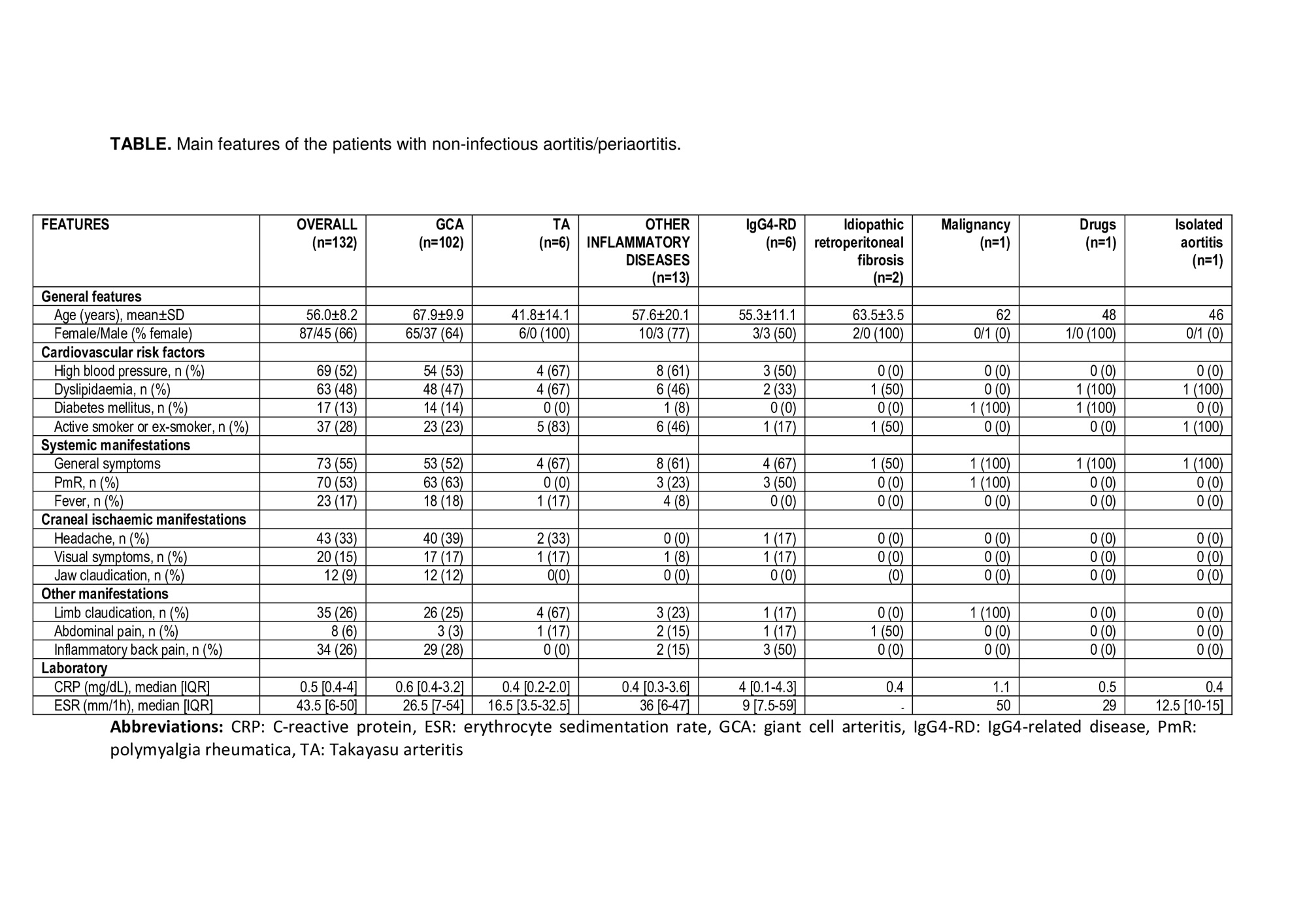Session Information
Date: Sunday, November 12, 2023
Title: (0691–0721) Vasculitis – Non-ANCA-Associated & Related Disorders Poster I
Session Type: Poster Session A
Session Time: 9:00AM-11:00AM
Background/Purpose: Aortitis is the inflammation of the aortic wall, and can be idiopathic or associated with a cluster of infectious and non-infectious diseases (1-3). Periaortitis, is an inflammatory process arising from the adventicia of the aortic wall and extending into the surrounding periaortic space. The aim of this study is to assess the causes and the main features of patients with aortitis and/or periaortitis.
Methods: Observational study of patients with aortitis or periaortitis from a large-vessel vasculitis monographic consultation at a referral hospital from June 2022 to April 2023. Aortitis and periaortitis were diagnosed by imaging techniques.
Results: We include 135 patients (87 female/ 48 male) (mean±SD age; 57.3±7.6 years). The different subtypes of aortitis/periaortitis were: Giant-cell arteritis (GCA) (n=102), Takayasu arteritis (n=6), other immune mediated diseases (n=13), IgG4-related disease (IgG4-RD) (n=6), infectious (n=3), retroperitoneal idiopathic fibrosis (n=2), malignancy (n=1), drugs (n=1), and isolated aortitis (n=1). The imaging techniques used for the diagnosis of aortitis were: PET/TAC (n=134), TAC (n=44), and RMN (n=33). The main features of the patients with non-infectious aortitis/periaortitis are summarized in Table. Aortitis was most frequent in women. High blood pressure and dyslipidaemia was present in 52% and 48% respectively. Polymyalgia rheumatica and general symptoms were the more frequent manifestations. The underlying diseases in the group of aortitis related to other immune mediated diseases were: Sjögren syndrome (n=2), sarcoidosis (n=2), rheumatoid arthritis (n=2), axial spondyloarthritis (n=2), inflammatory bowel disease (n=1), primary biliary cirrhosis (n=1), lung fibrosis (n=1), recurrent pericarditis (n=1), and polyarteritis nodosa (n=1). The ascending thoracic aorta was the most frequently involved segment (Figure).
Conclusion: Aortitis can be isolated or secondary to infectious and more frequently to non-infectious processes. GCA is the most frequent cause, being common the presence of PmR and constitutional symptoms. The thoracic aorta, specially ascending, seems to be the most frequently involved segment.
References:
- Loricera J, et al. Rev Esp Med Nucl Imagen Mol. 2015. PMID: 26272121
- Prieto-Peña D, et al. Ther Adv Musculoskelet Dis. 2021. PMID: 34211589
- Loricera J, et al. Clin Exp Rheumatol. 2018. PMID: 29799390
To cite this abstract in AMA style:
López F, Loricera J, Secada C, García-Alcalde L, Núñez-Savar M, Ucelay-Aristi A, Blanco R. Aortitis and Periaortitis Spectrum in 135 Patients from a Single Referral Centre [abstract]. Arthritis Rheumatol. 2023; 75 (suppl 9). https://acrabstracts.org/abstract/aortitis-and-periaortitis-spectrum-in-135-patients-from-a-single-referral-centre/. Accessed .« Back to ACR Convergence 2023
ACR Meeting Abstracts - https://acrabstracts.org/abstract/aortitis-and-periaortitis-spectrum-in-135-patients-from-a-single-referral-centre/


